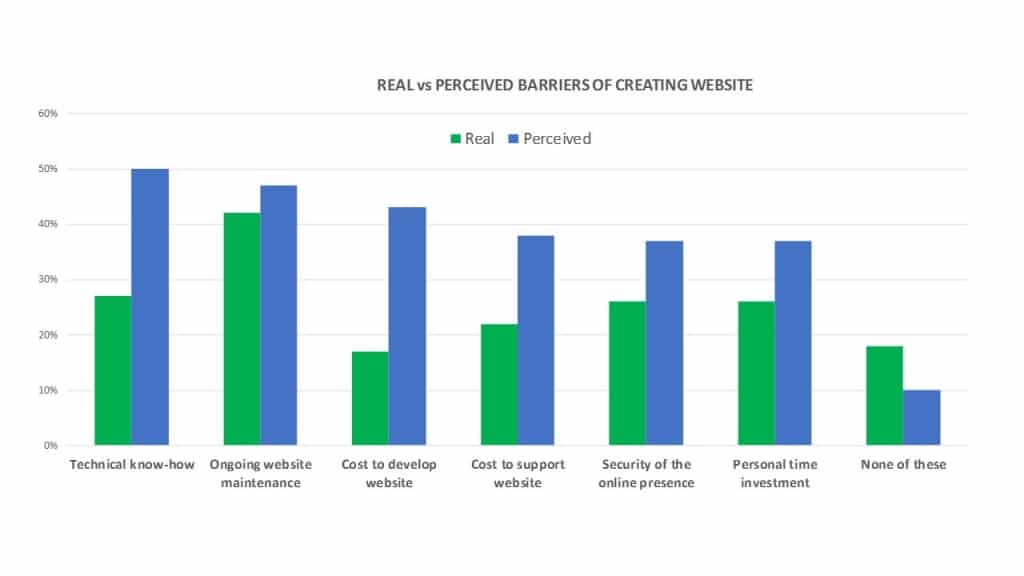Having a top-performing website is never easy. Although this is true for businesses of all sizes, small businesses are in for a bigger battle. Today, it’s indeed possible to build a website in less than an hour, however, it’s a different ball game when you’re planning to build a successful website that people actually want to visit.
Building an effective and responsive web design takes a long time to master, especially for small businesses. Why? It’s because unlike larger agencies, small businesses are in the beginning stages of growth, therefore making a name for themselves online and driving traffic to their site will take a lot more effort.
As the saying goes, the first step is always the hardest. This heavily applies to small businesses setting up websites because they have no momentum yet or they’re just starting to build it up.
The point where the website goes live is just the beginning and it will be challenging. Not only are you trying to drive traffic to your website, but with limited resources, you can’t risk going in the wrong direction and waste any of it.
So the questions remain.
What are the challenges small businesses face when building websites? How can they overcome these challenges and build a high ranking (and profitable) website?
Before we go ahead and answer these questions, let’s dive into why small businesses are growing very eager to get their businesses online.
Small Businesses Are Eager To Go Online
It’s not just small businesses who are feeling the need to shift their focus digitally. Businesses of all sizes are seeing the opportunity in the digital community and want to capitalize on it. The positive news is that now’s the perfect time to build your ecommerce website since consumers around the world are turning to online stores for their transactions. One of the reasons is that it minimizes human contact and people feel a lot safer because of it. In the US alone, click-and-collect ecommerce sales are expected to grow to USD 58.2 billion which is 60.4 percent more compared to 2019.
Now, more than ever, a website is the best tool that will essentially do everything for a business. From attracting leads, generating leads, nurturing leads, engaging customers, processing transactions, closing sales, and nurturing existing clients. All these will happen on your website, the possibilities are endless.
However, most small businesses are just catching up on this shift in consumer behavior. A study by Redshift Research commissioned by GoDaddy reveals that Small Businesses are quickly acknowledging the need for an online presence. The study reveals that 55% of small businesses without a website intend to create one within the next two years, and 48% of these expect to grow by 25% within the next three to five years. “We appear to be at a tipping point where, for competitive reasons and accessibility of tools, having its own online presence is now attainable for very small businesses,” the report said.
Beyond these “competitive reasons and accessibility of tools” is the larger shift in consumer expectations that small businesses have been slow to adapt to: consumers are now increasingly reliant on the internet to learn about products and services they want to purchase. With the rise of smartphones causing the number of proximity-based searches to surge, this is especially true for local businesses.
A study by Google revealed that 50% of consumers who conducted a local search on their smartphone visited a store within a day, 34% who searched on computer/tablet did the same, and 18% of Local Mobile Searches led to a sale within a day.
Can Small Businesses Catch Up With The Trend?
The answer is yes, but with great effort. As small businesses catch up with consumer expectations, the rush to establish an online presence is increasing the demand for Web Development and SEO services for small businesses. In order to compete in the big league, small businesses can work with Digital Marketing Professionals who offer Web Design Outsourcing Services. They can advise business owners on which direction to take in the early stages of building their website. Provided that these agency partners are sensitive to the needs of the small businesses so they can provide them with suitable solutions.
Barriers of Small Businesses — Real and Perceived
It’s not just small businesses that are feeling the need to shift their focus digitally. Businesses of all sizes are seeing the opportunity in the digital community and want to capitalize on it. The positive news is that now’s the perfect time to build your e-commerce website since consumers around the world are turning to online stores for their transactions. One of the reasons is that it minimizes human contact and people feel a lot safer because of it. In the US alone, click-and-collect e-commerce sales are expected to grow to USD 58.2 billion which is 60.4 percent more compared to 2019.
Now, more than ever, a website is the best tool that will essentially do everything for a business. From attracting leads, generating leads, nurturing leads, engaging customers, processing transactions, closing sales, and nurturing existing clients. All these should after you build a website or set-up an e-commerce business — the possibilities are endless.
However, most small businesses are just catching up on this shift in consumer behavior. A study by Redshift Research reveals that small businesses are now acknowledging the need for an online presence. The study reveals that 55% of small businesses without a website intend to create one within the next two years, and 48% of these expect to grow by 25% within the next three to five years. “We appear to be at a tipping point where, for competitive reasons and accessibility of tools, having its own online presence is now attainable for very small businesses,” the report said.
Beyond these “competitive reasons and accessibility of tools” is the larger shift in consumer expectations that small businesses have been slow to adapt to: consumers are now increasingly reliant on the internet to learn about products and services they want to purchase. With the rise of smartphones causing the number of proximity-based searches to surge, this is especially true for local businesses.
A study by Google revealed that 50% of consumers who conducted a local search on their smartphone visited a store within a day, 34% who searched on computer/tablet did the same, and 18% of Local Mobile Searches led to a sale within a day.
Before they created their websites, the main barriers these small businesses perceived were the technical knowledge needed to create a website (50%), the need for support on a monthly basis (47%), and the cost of developing these websites from scratch (43%).
Interestingly, once these businesses launch their websites, the perceived barriers they reported changed. The same businesses now cited monthly maintenance of their website (42%), the technical know-how (27%), the security of their online presence (26%) and the personal time devoted in getting their websites up and maintaining it (26%).
A key insight in the study is that small businesses’ main barrier is knowledge and time to create and support websites. While they understand the need and are willing to create their businesses’ websites, these barriers are holding them back from actually driving their business online.
Addressing these Barriers

There are two key elements to a successful website design service:
(1.) A fast, seamless web development experience that creates a high performing and responsive website for the client without taking them too much time or requiring technical knowledge
(2.) A monthly maintenance package that provides security and removes the hassle of having a website
To address the time requirement and technical knowledge barriers, web design services should be fast and seamless. This means focusing on three crucial touch-points and delivering on the client’s needs each time.
It starts with asking the right web design questions. This also allows agencies to manage the client’s expectations by informing them of what they can and cannot do on a website, and the key considerations and best practices in designing one before the project even starts.
Agencies that sell web design should also start offering website maintenance services. Once Small Business owners get past the initial hurdles of website set-up, they quickly realize that maintaining it isn’t so simple either. Maintenance packages should provide not only content uploads but also the backup, security check, and update services that clients need.
Building the Digital Presence and Beyond
It’s only when these small businesses get past these barriers that they can grow their business with digital marketing. With a solid website created with premium design and serviced monthly through a maintenance package as the centerpiece. Services such as SEO, Social Media, and paid advertisements become not only easier to execute, but an order of magnitude more effective.





